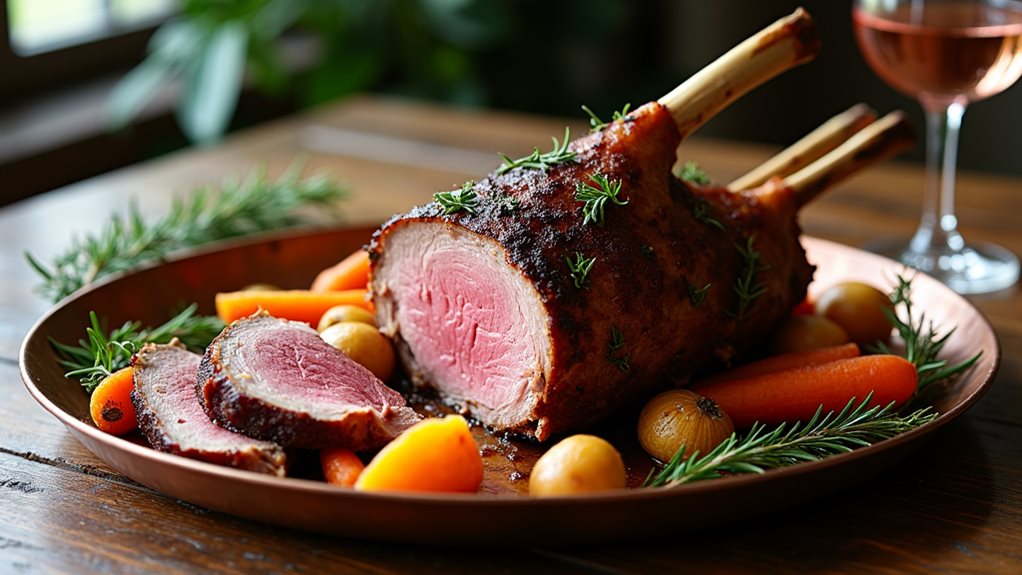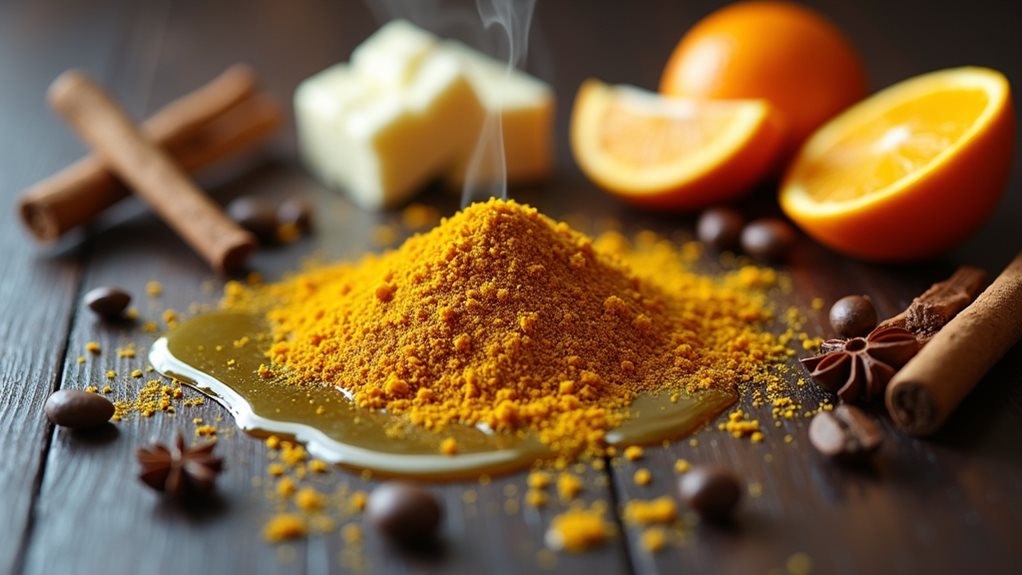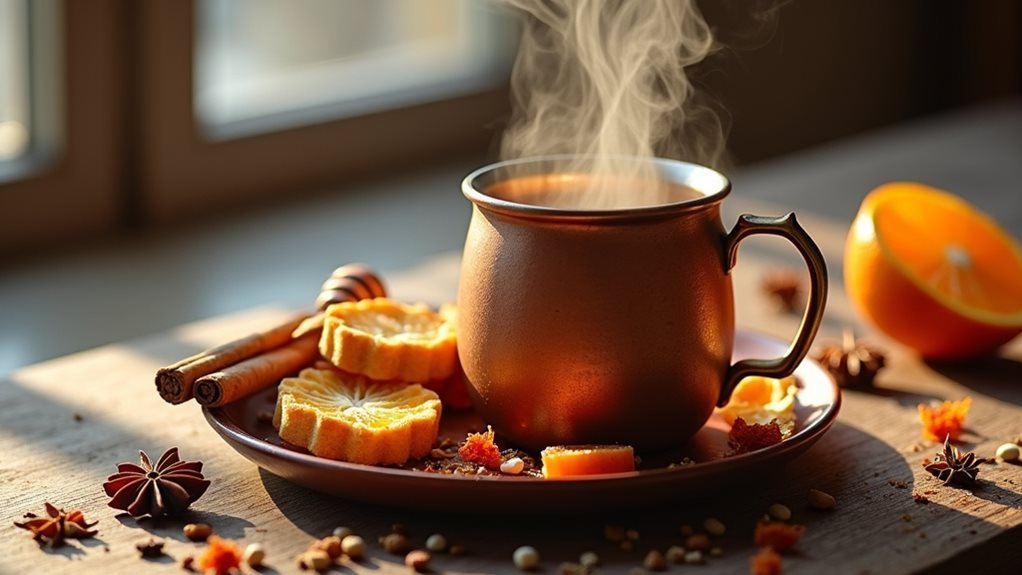You've likely encountered roast lamb dishes before, but this elegant combination of spring lamb, rosé wine, and citrus creates something truly distinctive. Whether you're planning an Easter celebration or seeking to impress dinner guests, this Mediterranean-inspired recipe transforms a traditional roast into a sophisticated centerpiece. The marriage of tender spring lamb with the subtle notes of rosé and bright orange zest isn't just about flavor—it's about creating an experience that engages all your senses. Let's explore how this remarkable dish came to grace modern tables and why it continues to captivate both home cooks and seasoned chefs alike.
Key Takeaways
- Baste spring lamb every 20 minutes with a mixture of rosé wine and orange juice to create a flavorful, caramelized exterior.
- Roast lamb at 375°F (190°C) for approximately 90 minutes until internal temperature reaches 135°F for medium-rare doneness.
- Score the lamb's surface with diagonal cuts before roasting to allow better absorption of wine and citrus flavors.
- The combination of rosé wine and orange enhances the natural sweetness of spring lamb while maintaining its tender, succulent texture.
- Let the roasted lamb rest for 15-20 minutes before carving to ensure juices redistribute throughout the meat.
History
Many ancient civilizations considered spring lamb a delicacy, with records dating back to early Mediterranean and Middle Eastern cultures.
You'll find that the tradition of eating young lamb in springtime has strong roots in religious celebrations, including Easter for Christians and Passover for Jewish communities, where it's played a central role in ceremonial feasts for thousands of years.
When you look at historical cookbooks from the 16th and 17th centuries, you'll notice that spring lamb recipes often featured aromatic herbs and wine-based sauces, much like today's preparations.
The French refined these cooking methods during the 18th century, introducing techniques you'd recognize in modern kitchens, such as slow roasting and basting. They'd typically pair the meat with seasonal vegetables and herbs that were emerging in their spring gardens.
You might be interested to know that the practice of aging lamb has evolved significantly.
While our ancestors would've eaten the meat quite fresh, today's chefs often prefer to age it briefly, allowing the flavors to develop more complexity and the texture to become more tender.
Recipe
Roast Spring Lamb Recipe
Spring lamb is renowned for its tender meat and delicate flavor, making it the perfect centerpiece for special occasions and family gatherings. The young lamb, typically harvested between 3-5 months old, offers a milder taste compared to regular lamb, with meat that's remarkably tender and succulent when properly prepared.
This classic roast spring lamb recipe combines traditional Mediterranean herbs with garlic and lemon to enhance the natural flavors of the meat while creating a crispy exterior and juicy interior. The key to success lies in proper seasoning and maintaining the right cooking temperature throughout the roasting process.
Ingredients:
- 4-5 lb leg of spring lamb
- 6 cloves garlic, minced
- 3 tablespoons (45 ml) olive oil
- 2 tablespoons (30 ml) fresh lemon juice
- 2 tablespoons (14 g) fresh rosemary, chopped
- 2 tablespoons (14 g) fresh thyme leaves
- 2 teaspoons (12 g) kosher salt
- 1 teaspoon (5 g) black pepper
- 1 cup (240 ml) white wine
- 2 onions, quartered
- 4 carrots, roughly chopped
Remove the lamb from refrigeration 1 hour before cooking. Preheat oven to 375°F (190°C). Mix garlic, olive oil, lemon juice, herbs, salt, and pepper to create a paste. Rub the mixture all over the lamb.
Place vegetables in a roasting pan, set the lamb on top, and add wine. Roast for 20 minutes per pound for medium-rare (internal temperature 135°F/57°C), basting every 30 minutes with pan juices. Let rest for 15-20 minutes before carving.
For best results, invest in a good meat thermometer to ensure precise cooking. The lamb can be studded with garlic cloves for extra flavor by making small incisions in the meat. If the surface browns too quickly, tent with foil to prevent burning.
The leftover pan juices can be reduced to make an excellent gravy by straining and simmering with additional wine or stock until thickened.
Cooking Steps
Your spring lamb preparation begins with preheating the oven to 375°F and creating a flavorful herb-garlic marinade that you'll massage into the meat after scoring it with diagonal cuts.
Once you've placed the seasoned lamb in a roasting pan, you'll need to roast it for approximately 90 minutes until it reaches your desired doneness, making sure to baste it regularly with the pan juices.
Throughout the cooking process, you'll want to monitor the internal temperature and brush the lamb with the remaining marinade every 20 minutes to ensure a moist, flavorful result.
Step 1. Preheat Oven to 375°F
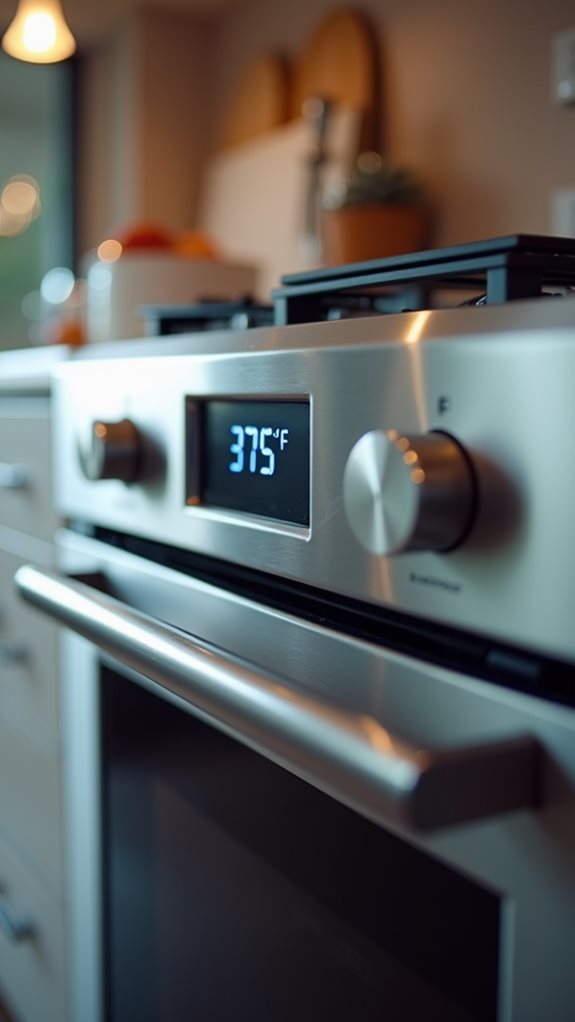
The first critical step in preparing a perfect spring lamb begins with properly preheating your oven to 375°F (190°C).
You'll want to allow at least 15-20 minutes for your oven to reach the correct temperature, as rushing this step can compromise your roast's final results. While you're waiting, ensure your oven racks are positioned correctly, with one rack placed in the middle for optimal heat distribution.
If you've got an oven thermometer, you'll want to verify the actual temperature, as many ovens can be slightly inaccurate.
Don't rely solely on the preheating indicator light or sound – these signals don't always guarantee your oven has reached the proper temperature throughout. For convection ovens, you'll need to adjust the temperature down by 25°F to compensate for the increased efficiency of heat circulation.
Once you've confirmed the temperature, maintain it steady for at least 5 minutes before introducing your lamb.
This consistency ensures your oven's ready to provide the even cooking environment needed for that perfect golden-brown crust while keeping the meat's interior tender and juicy.
Step 2. Prepare Herb-Garlic Marinade
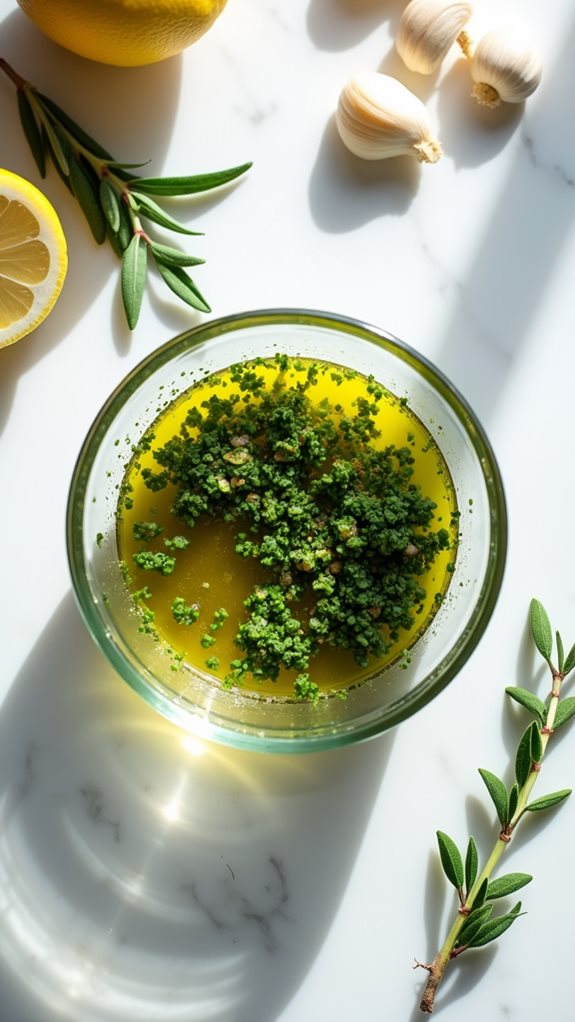
While the oven reaches temperature, it's time to create a flavorful herb-garlic marinade that will infuse your spring lamb with aromatic depth.
In a food processor, combine 6 peeled garlic cloves, 2 tablespoons of fresh rosemary leaves, 3 tablespoons of fresh thyme, and the zest of two oranges. Pulse until the herbs and garlic are finely chopped.
Add 1/4 cup of extra virgin olive oil, 1/2 cup of dry rosé wine, 2 tablespoons of Dijon mustard, and 1 tablespoon of kosher salt to the mixture. Process until you've achieved a smooth, emerald-green paste.
Transfer your marinade to a small bowl and stir in 1 teaspoon of freshly ground black pepper and the juice from one of your zested oranges.
You'll want to reserve 1/4 cup of the marinade for basting during cooking. Using your hands, massage the remaining marinade thoroughly into your lamb, making sure to work it into any natural seams or crevices in the meat.
Let the lamb rest with the marinade for 15-20 minutes before proceeding with roasting.
Step 3. Score Lamb With Knife
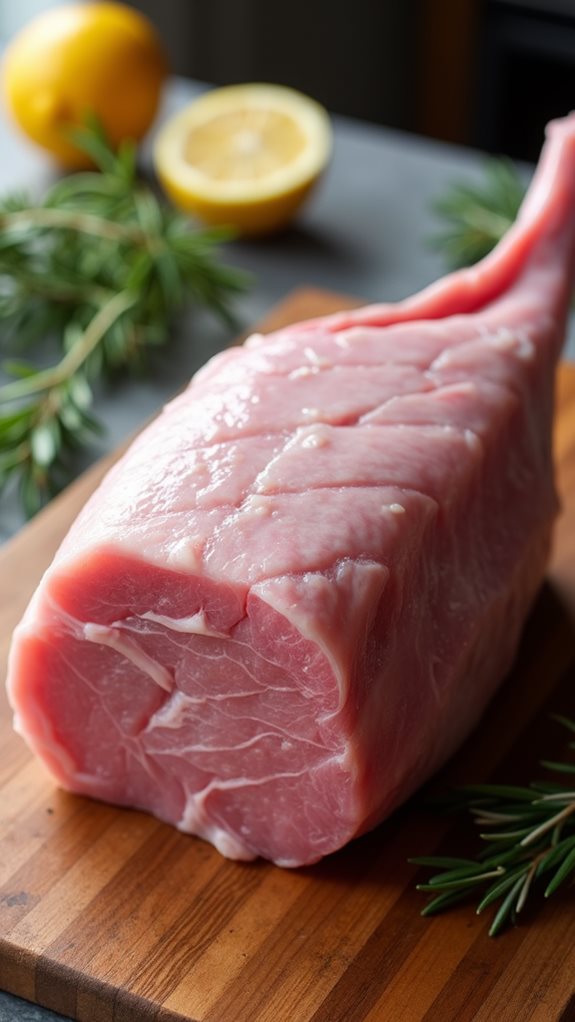
Sharp blade in hand, scoring your marinated lamb creates essential pathways for rendered fat and deepens flavor absorption.
You'll want to make precise, shallow cuts approximately 1/4 inch deep across the surface of the meat, creating a diamond pattern that'll enhance both presentation and taste. Position your knife at a 45-degree angle to achieve clean, deliberate incisions.
Start by making parallel cuts about 1 inch apart across the entire surface, then rotate the lamb 90 degrees and repeat the process to form the characteristic crosshatch pattern.
Don't press too deeply, as you're not trying to pierce through the meat – your goal is to create surface channels that'll help the fat render and allow the marinade to penetrate more effectively.
If you're working with a leg of lamb, focus on scoring the fatty areas first, then extend the pattern across the leaner sections for consistency.
Be extra careful when scoring around joints or irregular surfaces, adjusting your grip to maintain control of the blade.
Once you've completed the scoring, you'll notice the diamond pattern creates small peaks that'll crisp beautifully during roasting.
Step 4. Roasting Lamb for 90 Minutes
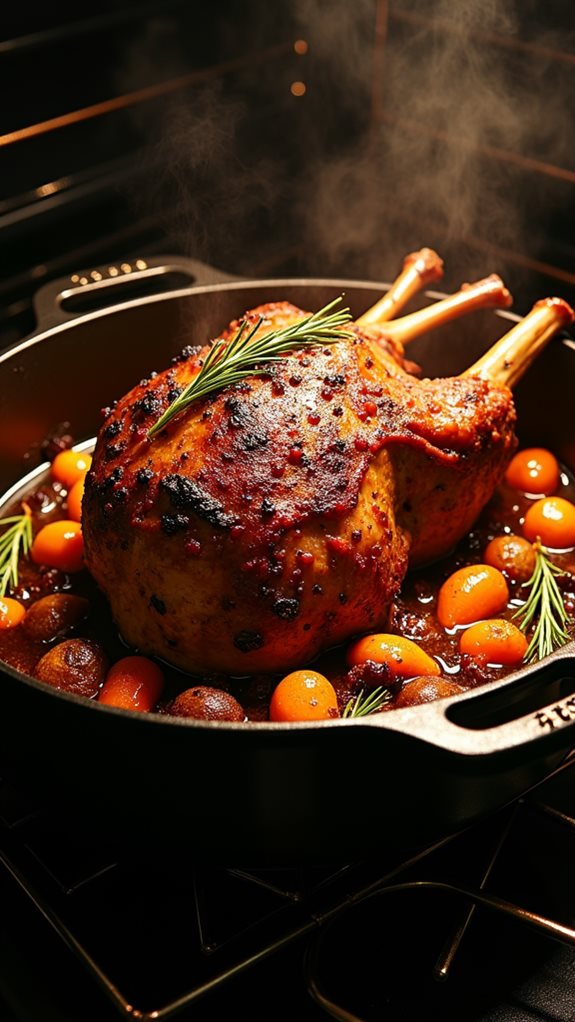
After preheating your oven to 375°F (190°C), position the scored lamb on a roasting rack inside a deep roasting pan. Pour the rosé wine mixture around the lamb, being careful not to wash away the herb coating you've applied to the meat's surface.
You'll want to place orange wedges and garlic cloves in the pan's bottom, as they'll help create a flavorful sauce during cooking.
Roast the lamb for the first 45 minutes uncovered, basting every 15 minutes with the pan juices to keep the meat moist and develop a golden crust.
After this initial period, cover the roast loosely with foil to prevent over-browning, and continue cooking for another 45 minutes.
You'll know the lamb is done when a meat thermometer inserted into the thickest part reads 135°F (57°C) for medium-rare or 140°F (60°C) for medium.
Don't forget to let the meat rest for 15-20 minutes after removing it from the oven, as this allows the juices to redistribute throughout the roast.
During this time, you can strain and reduce the pan juices to create a complementary sauce.
Step 5. Baste Lamb With Sauce
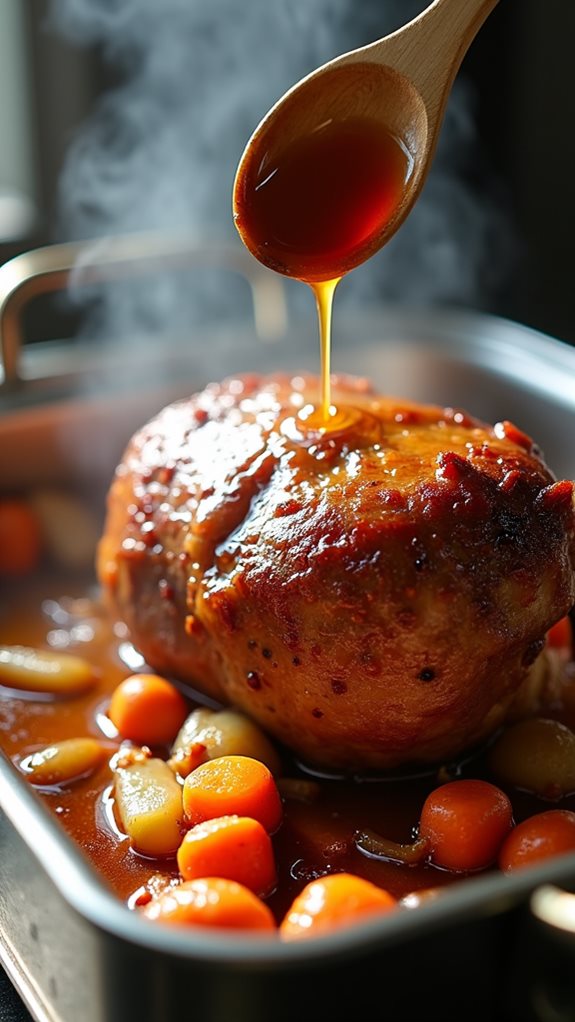
Basting your lamb requires careful attention to timing and technique throughout the cooking process. You'll need to baste the meat every 20 minutes with the pan juices, which will have combined with the rosé wine and orange sauce to create a rich, flavorful liquid.
Using a large spoon or turkey baster, collect the juices from the bottom of the roasting pan and drizzle them evenly over the entire surface of the lamb.
When you're basting, don't rush the process. Make sure you're coating all sides of the meat, including the areas where the lamb makes contact with the roasting rack.
If you notice the pan juices becoming too dark or starting to reduce too much, add a quarter cup of warm water to maintain the proper consistency. The basting liquid should be thin enough to pour but thick enough to coat the back of a spoon.
During the final 30 minutes of cooking, you'll want to increase the basting frequency to every 10 minutes, which will help develop that sought-after golden-brown crust while keeping the meat moist and tender.
Final Thoughts
Looking for the perfect springtime meal to impress your guests? This roast spring lamb recipe delivers an elegant dining experience that's sure to create lasting memories around your table.
You'll find that the combination of rosé wine and orange creates a sophisticated flavor profile that enhances the natural sweetness of spring lamb.
When you've mastered this recipe, you'll appreciate how the careful timing and temperature control result in meat that's perfectly pink inside while maintaining a beautifully caramelized exterior.
Don't hesitate to adjust the seasonings to your taste, though the provided measurements offer an ideal balance that complements the lamb's natural flavors.
While the cooking process requires attention to detail, you'll discover it's well worth the effort for special occasions or weekend family dinners.
Remember to let your lamb rest for at least 15 minutes before carving, and don't forget to serve it with the reduced sauce you've created.
The leftover meat, if you're lucky enough to have any, makes excellent sandwiches the next day.
You've now got a show-stopping dish that's bound to become a springtime tradition in your home.

